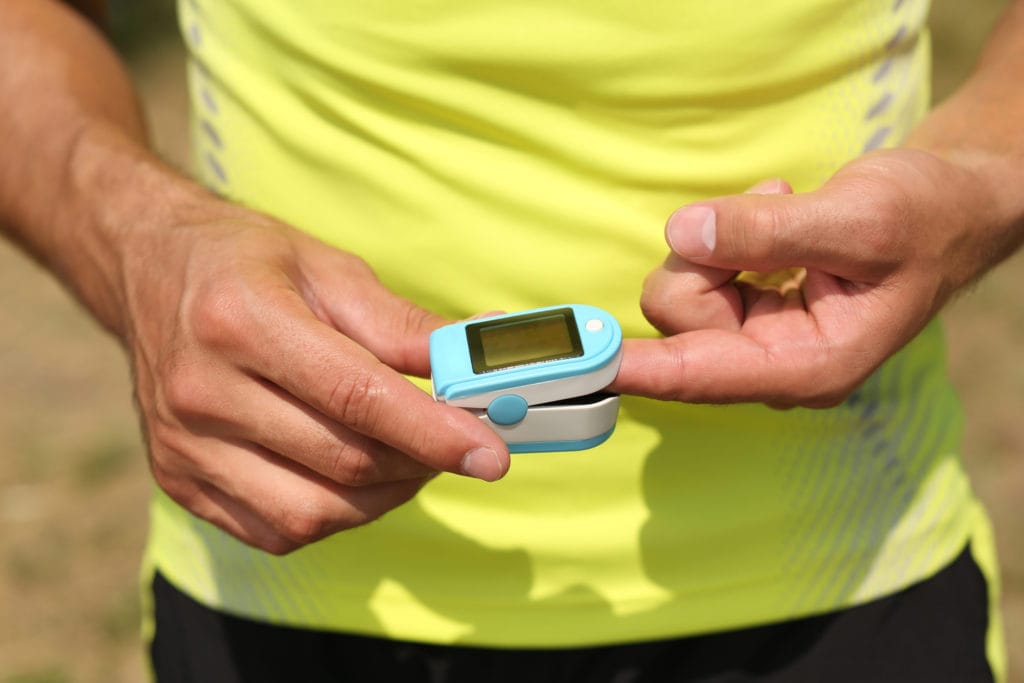Pulse oximeters are in use by many endurance athletes and by many trekkers who wish to accomplish high altitude journies. The athletes may use a pulse oximeter device to monitor the oxygen in the blood to optimize the training. Trekkers and climbers may use this device to keep safe in the mountains, maintaining the required below-danger level of oxygen to not risk the body to fatality.

Pulse oximetry check is a test used to measure the oxygen level (oxygen saturation) of the blood. Using a light detection sensor, the device indicates the available oxygen to the body parts. Pulse oximeters provide an estimate of the oxygen saturation by taking advantage of the fact that oxygenated and deoxygenated hemoglobin absorbs light differently from each other.
Although the devices are very helpful and simple to use, data output may be inaccurate or hard to interpret in certain situations. This could lead to inappropriate clinical related decisions. For the case of the athlete, this may lead to a not optimized training routine. For the case of the climber, the required alert of lack of oxygen can be late in time and adding risk to the expedition. It is important to benefit from using this device, by a proper operation and data interpretation.
Acute Mountain Sickness from the lack of oxygen can lead to the progression to its severe manifestations: high–altitude pulmonary edema (HAPE) and high-altitude cerebral edema (HACE).
Furthermore, Patients with Underlying Cardiopulmonary Disease Traveling to High Altitude are more susceptible to lack of oxygen and are under higher risk. Monitoring such travelers, among other sensitive groups is a life-saving act even not at very high altitudes.
It is unclear, however, if there is a direct link between summit success and low saturation measurement at the start of the route or during the ascent. Some researches support such a link while others gave questionable results. In any case, it is agreed that a low oxygen saturation value is a clear risk indicator.
Several factors can impact the accuracy of the readings. It is important to pay attention to how and when you are taking the measurement. very cold hands can impact blood circulation to the fingers and can impact the oxygen reading. If you are after heavy smoking, the measurement can be inaccurate too because the oximeter can’t tell the difference between blood that is carrying oxygen, and blood that is carrying carbon monoxide. Smoking increases the carbon monoxide in your blood, and the pulse oximeter can give a falsely high reading. Abnormal heart rate, measurement in non-resting conditions can lead to accuracy issues as well.
In high altitude, we should not judge the oximeter results based on a single measurement with a specific value. Instead, we should look at the trend of results from previous days and previous measurements. Also when saturation reading is lower than 80%, there is higher inaccuracy. So we want to treat the measurement as ranges (75%~80%, 70%~75%).
At sea level, the normal oxidation value is around 97%~99%, while in high altitude, being above 85% saturation rate, at 4000meters high (~13,123ft), is normal.
Research done over a group of childer living in high altitudes (above 4000 meters) found the average value of the oximeter reading was 87.3%. In other research, a group of males was tested at 725meters compared to sea level and showed a 95% oxygen saturation rate compared to 97% at sea level.
Researches found pulse oximetry measurement to be a valid way to predict and monitor hemoglobin. Higher hemoglobin means higher oxygen vassals, hence the ability to carry oxygen more efficiently. A higher measurement means you still have the ability to carry more oxygen to your muscles.
An additional interesting fact about inaccuracy at a high altitude of the pulse oximeter is that travelers who cooked inside a tent where “poisoned” by the stove. In such cases, the pulse oximeter may overestimate the true oxygen saturation in a person with significant carbon monoxide exposure.
There are several portable oximetry devices. In most cases, the small external fingertip device is a great choice. It is cheap, accurate, and can be shared between the team members. Among a team of climbers, one device will serve all.
As mentioned, the primary function of this device is to monitor oxygen levels (also, giving heart rate reading simultaneously). Athletes may choose to utilize this as a tool during strenuous workouts. Endurance, speed, and efficiency are all important goals for any athlete. M maintaining an effective oxygen range can drastically improve one’s overall performance. It can help develop these components. Using a pulse oximeter to monitor your oxygen levels while working out can help you make adjustments so that you are getting more equalized oxygen flow throughout your workout session.
Athletes who exercise in relatively high altitude environments can benefit from using the oximeter even more. Better monitoring of the oxygen during the endurance effort may optimize the results. The athletes may reach closer to their limits, without reaching situations of severe lack of oxygen.
There are additional cases where the pulse oximeter can help with fitness matters. Individuals affected by respiratory illnesses, including asthma, can monitor the level of oxygen to help to avoid an alarming respiratory attack.
In summary, the pulse oximeter is a very valuable and cost-effective device. It may improve security on the mountains for the trekkers and can improve the performance of athletes. Like any other monitoring equipment, it is important to use it in the right conditions. By doing so, the monitoring will be valuable, can improve performance and reduce unnecessary risks.
We will be in Breckenridge and Estes Park CO in late January. My husband needs a pulse ox due to sleep apnea. Which one do u recommend at that altitude? Thanks!